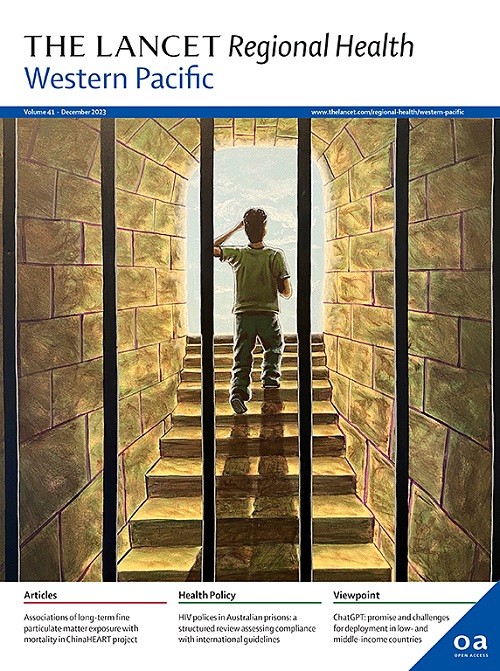Changing age profile and incidence of injecting drug use initiation among people in Australia who inject drugs: evidence from two national repeated cross-sectional studies
IF 8.1
1区 医学
Q1 HEALTH CARE SCIENCES & SERVICES
引用次数: 0
Abstract
Background
The age of people who inject drugs appears to be increasing in some high-income countries. We aimed to explore trends in the age of people injecting and recently starting to inject drugs in Australia, and to model incidence of initiation over time.
Methods
We obtained data from the Illicit Drug Reporting System (IDRS) and the Australian Needle Syringe Program Survey (ANSPS), which comprise annual cross-sectional surveys with people who inject drugs (2000–2019). Outcome measures were current age, age of initiation, and time since initiation (both surveys), and drug first injected (IDRS only). We estimated time trends in age using quantile regression. We used the relative number of people initiating injecting drug use each year and existing population size estimates to model incidence of initiation.
Findings
In total, 58,465 interviews with people who reported injecting drugs in the past month (33.7% women) were included. In both surveys, the median age increased over the study period (IDRS: 28–43 years; ANSPS 28–44 years). The median time since initiation also increased over the study period (IDRS: 8–22.5 years; ANSPS: 9–24 years), and the median age of initiation increased with calendar year of initiation (IDRS: 18–34 years; ANSPS: 20–30 years). Women tended to be younger and commence injecting drug use at a younger age than men. Modelling suggested that similar numbers of people injected drugs for the first time each year from 1980 (national estimates of 15,570 and 17,020 new initiates using IDRS and ANSPS data, respectively) to 1996 (IDRS: 16,360; ANSPS: 22,300 new initiates), followed by a decisive decline in incidence until 2012 (IDRS: 1110; ANSPS: 1830), whereafter it has fluctuated but remained low. Meth/amphetamine was consistently the predominant drug injected at initiation among IDRS participants, although there were peaks in heroin as the drug injected at initiation in the early 1980s and mid-1990s.
Interpretation
In 2019, most people who were injecting drugs in Australia were part of a cohort that began injecting in the 1980s or 1990s. Consequently, the population was older and had been injecting drugs for longer compared to those injecting drugs in 2000. This has implications for health service delivery to people who inject drugs, with increasing age likely to be accompanied by a rise in chronic health conditions and an increase in injecting duration potentially resulting in higher incidence of injecting-related injuries and diseases.
Funding
Australian Government Department of Health and Aged Care.
在澳大利亚注射毒品的人群中,年龄分布的变化和注射毒品开始使用的发生率:来自两项全国性重复横断面研究的证据
背景:在一些高收入国家,注射吸毒者的年龄似乎在增加。我们的目的是探索在澳大利亚注射毒品和最近开始注射毒品的人群的年龄趋势,并建立一段时间内开始注射毒品的发生率模型。方法从非法药物报告系统(IDRS)和澳大利亚针头注射器计划调查(ANSPS)中获取数据,其中包括2000-2019年对注射吸毒者的年度横断面调查。结果测量指标为当前年龄、起始年龄、起始时间(两项调查)和首次注射药物(仅限IDRS)。我们使用分位数回归估计年龄的时间趋势。我们使用每年开始注射吸毒的相对人数和现有的人口规模估计来模拟开始吸毒的发生率。调查结果:在过去一个月里,总共有58,465名报告注射毒品的人接受了采访(33.7%是女性)。在这两项调查中,中位年龄在研究期间有所增加(IDRS: 28-43岁;ANSPS 28-44岁)。在研究期间,自开始治疗以来的中位时间也有所增加(IDRS: 8-22.5年;ANSPS: 9-24岁),起始年龄中位数随着起始历年的增加而增加(IDRS: 18-34岁;ANSPS: 20-30年)。妇女往往较年轻,开始注射吸毒的年龄比男子小。建模表明,从1980年到1996年,每年首次注射毒品的人数相似(使用IDRS和ANSPS数据的全国估计数分别为15,570人和17,020人)(IDRS: 16,360人;ANSPS: 22,300例新发病例),随后直到2012年发病率明显下降(IDRS: 1110;ANSPS: 1830),此后它有所波动,但仍然很低。甲基安非他明一直是IDRS参与者开始注射的主要药物,尽管海洛因作为开始注射的药物在20世纪80年代初和90年代中期达到高峰。2019年,澳大利亚大多数注射毒品的人都是上世纪80年代或90年代开始注射毒品的人。因此,与2000年的注射吸毒者相比,人口年龄更大,注射毒品的时间更长。这对向注射吸毒者提供保健服务产生影响,因为年龄的增长可能伴随着慢性健康状况的增加和注射时间的延长,可能导致与注射有关的伤害和疾病的发生率增加。资助澳大利亚政府卫生和老年护理部。
本文章由计算机程序翻译,如有差异,请以英文原文为准。
求助全文
约1分钟内获得全文
求助全文
来源期刊

The Lancet Regional Health: Western Pacific
Medicine-Pediatrics, Perinatology and Child Health
CiteScore
8.80
自引率
2.80%
发文量
305
审稿时长
11 weeks
期刊介绍:
The Lancet Regional Health – Western Pacific, a gold open access journal, is an integral part of The Lancet's global initiative advocating for healthcare quality and access worldwide. It aims to advance clinical practice and health policy in the Western Pacific region, contributing to enhanced health outcomes. The journal publishes high-quality original research shedding light on clinical practice and health policy in the region. It also includes reviews, commentaries, and opinion pieces covering diverse regional health topics, such as infectious diseases, non-communicable diseases, child and adolescent health, maternal and reproductive health, aging health, mental health, the health workforce and systems, and health policy.
 求助内容:
求助内容: 应助结果提醒方式:
应助结果提醒方式:


